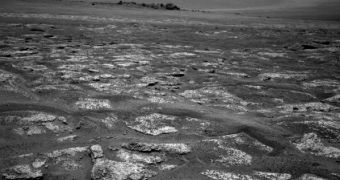Experts analyzing data from the NASA Mars Exploration Rover (MER) Opportunity announced on Wednesday, December 7, that the rover recently discovered a vein of minerals on the surface of Mars. The material, which appears to be gypsum, could have only been deposited by water.
The finding represents an extremely important step towards boosting our understanding of how our neighboring planet used to look like millions to billions of years ago. We now know that it once had liquid water on the surface, but details of what happened are still scarce.
Opportunity and its twin, Spirit, have thus far provided large volumes of data on Martian water history, but experts are well aware that a lot more remains to be discovered. The purpose of the newly-launched Mars Science Laboratory (MSL) mission is to aid in this regard.
What details Opportunity could gain of the newly-found gypsum vein were presented at the fall meeting of the American Geophysical Union, which is being held in San Francisco. The formation is 0.4 to 0.8 inches wide and 16 to 20 inches long (1 to 2 centimeters by 40 to 50 centimeters).
“This tells a slam-dunk story that water flowed through underground fractures in the rock,” said the principal investigator for Opportunity's science mission, expert Steve Squyres. He is based at the Cornell University, in Ithaca, New York.
“This stuff is a fairly pure chemical deposit that formed in place right where we see it. That can't be said for other gypsum seen on Mars or for other water-related minerals Opportunity has found,” he told attendants at the conference.
“It's not uncommon on Earth, but on Mars, it's the kind of thing that makes geologists jump out of their chairs,” the expert added. He said that the formation, and many other like it, was discovered around the rim of Endeavour Crater.
Since the rover arrived at Mars, in 2004, it has traveled more than 20 miles (33 kilometers), and yet it has never discovered anything like this before. But good fortune allowed the machine to find this gypsum vein by using its Microscopic Imager and Alpha Particle X-ray Spectrometer instrument.
By analyzing how much calcium and sulfur was present in the mineral, the science team was able to determine that the material is made up of relatively pure calcium sulfate. Additional observations indicated that it could even hydrated calcium sulfate (gypsum).
At Opportunity's current location, “we see the mineral right where it formed. It will be important to see if there are deposits like this in other areas of Mars.” Space Science Institute expert and Opportunity science team member Benton Clark concludes.

 14 DAY TRIAL //
14 DAY TRIAL //